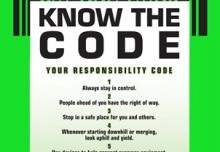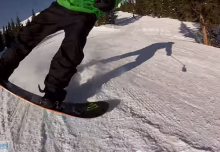Last Friday, the unthinkable happened to me. I was coming down a blue square run on the California side of Heavenly, Ridge Run. It’s a wide open groomer that is as much as 40-50′ wide most of the way down. I was obeying the slow signs and only traveling at about 20mph down the run, well within what Ski Patrol and Mountain Safety would consider a slow speed.
I was approaching a woman skiing who was about 40′ downhill and 30′ left of my line, which was at the far right of the run, adjacent to a mogul field. She had made about 5 or 6 consistent turns from when she came into my field of vision. Out of nowhere, she made a hard right, completely cutting me off. Even though I’d given her plenty of space, there was simply no accounting for such an abrupt turn.
In the split second that all of this occurred, I had basically two options. The first was to thrust myself into the mogul field, potentially ending my season by bouncing off mogul tops. The second was to run into the skier, which was what happened. Ultimately, I had so little time to react, the latter was what would likely have occurred in 99 out of 100 replays of this same scenario.
If I had to guess at the statistics, I would think that more often than not, collisions on the mountain occur between experts and beginner/intermediates more frequently than between fellow beginner/intermediates. That said, I am of the opinion that the primary cause of collisions on mountain occur primarily because of the beginner/intermediate level skier’s/rider’s failure to follow the skier’s code (which applies to both skiers and riders).
Skier’s code is as follows:
- Always stay in control, and be able to stop or avoid other people or objects.
- People ahead of you have the right of way. It is your responsibility to avoid them.
- You must not stop where you obstruct a trail, or are not visible from above.
- Whenever starting downhill or merging into a trail, look uphill and yield to others.
- Always use devices to help prevent runaway equipment.
- Observe all posted signs and warnings. Keep off closed trails and out of closed areas.
- Prior to using any lift, you must have the knowledge and ability to load, ride and unload safely.
Rule 4 discusses looking uphill and yielding to others. In my opinion, this rule is incomplete because it doesn’t address the importance on looking uphill while on a run and traversing the run you’re already going down. When I have experienced near misses when going down a run, it’s pretty much always been because someone downhill of me has been making multiple turns in a predictable manner then, out of nowhere, makes a huge left or right across the run effectively eating my line down the mountain while failing to look uphill to make sure they aren’t cutting someone off. I’ll get back to this later…
I’m all for stopping in a safe place, which is part of Rule 3, but it’s important for the skier/rider doing so to look uphill first to avoid taking someone’s line who may be faster and more skilled in their discipline. By checking your shoulder, you will avoid the near miss or an actual collision because you will see someone coming down the hill above you and can make a quick turn to stay out of their path of travel.
I felt horrible. That someone with my morals and dedication to riding safely and helping others on the mountain do the same, a former instructor, now a blogger about the sport, could be involved in a collision was the unthinkable becoming reality. In spite of all of my skills, expertise, and experience and regardless of how much extra space I’ve been giving others on the mountain due to the icy conditions this season, I had collided with another person on the mountain.
A couple of people stopped right away and I told them I was going to head down to get Ski Patrol. When I got to the lift, I asked the lift operator to alert Ski Patrol and send them to ridge run. I then loaded Sky Chair. On my way up, I considered my options: flee to Nevada side and suffer no consequences with my season pass or return to the scene of the accident in full knowledge that my pass would be suspended because of protocol. It was a no-brainer for me. To flee the scene was not only immoral but not knowing if this woman was okay was something that I simply could not live with. I had to know if she was okay. Even though I believe that this accident was entirely not my fault, the fact is that the two of us had been in a collision and while I sustained injuries, I was able to ride down to get help. She was immobilized and in serious pain.
When I returned to the scene, there were 3 Patrollers and 3 Mountain Safety on the scene. I stopped by a Mountain Safety and introduced myself and told him that I was the one who had struck this lady. He thanked me for coming back (from his tone, I guessed that this doesn’t happen very often) and then informed me that protocol dictated that he suspend my pass.
I then went down to her and asked her if she could move her arms and legs. She had been stationary for so long, I feared the collision may have paralyzed her. She then did move her arms then her legs and I burst into tears. I was so happy to see that the injuries, if any, weren’t life changing in the worst kind of way. I pretty much cried the entire time as I stayed on the scene and helped Ski Patrol load her onto a stretcher to take her down to medical. This shook me up very badly and I felt horrible that I had been a part of this.
As for me, I sustained badly bruised ribs and my jaw is very sore from my impact on the ground after the collision which damaged my ribs. It has hurt to cough, laugh, yawn, bend over, get out of my car, or anything else that involves movement of the rib cage since the incident 6 days ago. I have slept a lot. It sucks.
Both of us have had our health and seasons affected by this accident. Unfortunately, the primary reason this accident occurred was because she failed to check her shoulder when traversing from the center-left of the run to the far right of the run. Had she looked uphill, she would have seen me and been able to make a quick left to stay out of my line.
As I mentioned earlier, I was only going 20mph. I know this because of the app I use, Alpine Replay, which provides users with a histogram of every run as part of the stats users get. When I got back to Stagecoach Lodge, I uploaded my stats for the day and reviewed the run and learned that I was only going about 20mph before the accident. I knew I was going slow but this confirmed it. It also confirmed that this accident was in no way my fault. I’m in no way putting blame on this woman, but I feel that if she had checked her shoulder there would have been no collision.
This is what I consider to be the primary reason why collisions occur on the mountain – the downhill skier/rider’s failure to check their shoulder when making a hard traverse to the side of the run. It’s the part of Rule 4 that is not stated explicitly. Merging onto a trail implies that you are coming from one trail onto another. In reality, when you are making predictable turns while on a trail, when you make an unpredictable turn toward the left or right side of the run, you are effectively merging with others already coming down the side of the run and, therefore, need to look uphill as if you were merging from one trail to another for all the same reasons.
This whole situation is all bad and something I never want to experience again. My best advice is to be predictable when on the mountain and if you do something inconsistent with the turns you’ve been making to check your shoulder, look uphill, and make sure you’re not taking someone’s line.
This is an extreme sport. People suffer life-changing injuries, or worse. Safety is paramount and you don’t want someone plowing into you from uphill. The best way to avoid this is to look uphill as often as possible.
Be safe out there. Collisions can happen to anyone…even experts!
Flo



